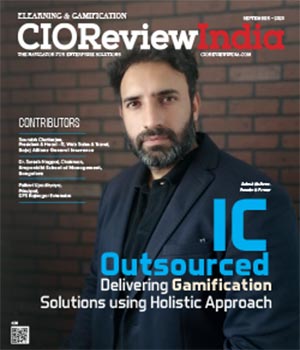
Brief Introduction To Six Sigma Philosophy
CIOReview Team | Tuesday, 21 April 2020, 14:41 IST
“Six Sigma is a quality program that, when all is said and done, improves your customer experience, lowers your costs, and builds better leaders.” - Jack Welch
‘Quality Management’ ensures top quality products and services. A product or service is considered to be top quality when it is perfect in performance, reliability, and durability. It is very important to carry out quality management processes because it is the quality that gives you customer satisfaction and eventually the success of your product or service. The parameters that decide the quality of a product can be its functionality, performance, reliability, relevance, timeliness, suitability, completeness and most importantly the consistency of the product.
Using Quality Management tools helps an organization in designing and creating the products according to the requirements of the customers. Another major importance of using quality management tools is that it ensures higher productivity and increased revenues for the organization.
Also, managing quality helps an organization to reduce wastage and inventory. It maintains close coordination among the employees of an organization.
Quality Management is the process that is carried out from the beginning of the project to the end while ensuring that the activities required to design, plan and implement a project are efficient and effective the objective and performance of the product.
With quality management being so crucial for an organization, let us read about one such methodology used for quality management, which is Six Sigma. We would also know more about Six Sigma certifications and how taking up training programs, like a Six Sigma Black Belt Certification, is beneficial for you.
What is Six Sigma?
Six Sigma is a methodology used for quality management that is used to help organizations to improve their products and services by finding out and eliminating defects. The goal of using Six Sigma is to streamline quality control is manufacturing business processes such that there is little or no variance anywhere. Trademarked in 1992 by Motorola, Six Sigma is designed specifically to help organizations with quality management. Let us now read about the methodologies involved in Six Sigma.
Six Sigma Methodologies
There are two sub-methodologies that Six Sigma usually follows. Those are DMAIC and DMADV.
Six Sigma DMADV
DMADV is an acronym for the steps involved in this methodology which are Define, Measure, Analyze, Design and Verify.
The steps involved in DMADV are:
- Define:You need to define realistic goals in order to meet the customer’s requirements or business strategies.
- Measure:Next you are required to measure and identify the requirements of customers that are critical to quality (CTQ) and translate them into goals that are clear for the project.
- Analyze:Next comes the analysis of various alternatives for the customer according to the total estimated life cycle of the project.
- Design:The next step is to design the prototype to find out errors and modify them so as to move further into a detailed version.
- Verify:The final step is to verify the ultimate iteration of the product or process that is validated by the customers and clients - both external and internal.
This methodology is also called DFSS or Design for Six Sigma.
Six Sigma DMAIC
The Six Sigma DMAIC methodology also includes five phases as DMADV. DMAIC is an acronym for the steps involved, which are Define, Measure, Analyze, Improve and Control. The steps involved are:
- Define:The very first step is to define the problem and the project requirements along with the ultimate goals according to the requirements of the customers.
- Measure:It is required to measure the performance of the on-going process that is done by stablishing a data collection plan. This is done to determine the defects in the project and gather the related metrics.
- Analyze:The next step includes the analysis of the process to initiate the root cause of defects and variations to identify issues with the current strategy that disturbs the process in achieving the end goal.
- Improve:The improvement of the process is done by eliminating the root grounds of defects by finding out innovative solutions.
- Control:the final step is to control the new process so that previous errors are prevented and makes sure that it keeps on the track.
DMAIC Vs. DMADV
At first glance, both of the methodologies seem to have the least differences, but they are carried out in different situations. DMAIC is carried out when the existing processes or products are found unable to meet the customer’s requirements and are not performing to the expected standards. DMADV is designed for the circumstances when a business needs to develop or create a new product or process or when the existing product doesn’t perform as expected in spite of being optimized.
Six Sigma Certifications
Motorola and GE were the first to develop the Six Sigma Certification program that verifies the candidate’s proficiency in using Six Sigma methodologies. A Six Sigma Certification validates the skills of professionals in identifying risks, errors, or defects in a business process and finding out ways of removing them. There are various certifications offered by Six Sigma, the accrediting bodies being ASQ and IASSC. Let us read about them in brief.
The ASQ Certification Exam
ASQ or American Society for Quality, one of the most widely recognized organizations for Six Sigma and Lean Six Sigma associations, offers Black Belt and Green Belt Certifications.
ASQ is an open book exam which clearly means that you don’t need to memorize the things, you can focus on understanding the concepts instead. The ASQ makes sure that professional Six Sigma training and certifications are conducted as per the standards of the global industry. Note that Lean Six Sigma certifications are not offered by ASQ.
The IASSC Certification exam
IASSC offers the most affordable Six Sigma certifications. The IASSC offers Black Belt, Green Belt, and Yellow Belt certifications. It conducts closed book exams that means you are required to memorize a lot of concepts in order to pass the exam. There are exam guides created according to the Body of Knowledge or BoK of IASSC in order to help you make learning go easy.
Conclusion
Six Sigma certifications can be very helpful in growing your career because it makes you an expert in finding errors and their elimination. Hence it raises your managerial levels in an organization. You would surely add these certifications to your resume. To get certified you should go for training providers that are accredited by either IASSC or ASQ. It should provide you the options of learning at your own pace and also provide you the options in the mode of delivering the training as in classroom, instructor-led or blended learning approach.
CIO Viewpoint
Cloud Enabled Edtech Spaces Enriching Learning...
By CIOTechOutlook Team
Challenges and Issues of Online classes
By R. Chandran, Chief Information Officer, Bahwan Cybertek
Educational Technology, Digital Learning In The...
By Swati Sankhye, Chief Information Officer, MIT World Peace University
CXO Insights
Optimon: Smart Manufacturing Solutions...
By Srinivas Kallakurchi, President & Chief Strategy Officer
Education Should Be A Want And Not A Need
By Dr. Prem Das Maheshwari, Business Director, South Asia, D2L
Current Industry Trends In Education














